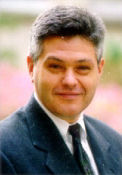
Andrew F.X. Goldberg, PhD
Andrew F.X. Goldberg, PhD, Associate Professor of Biomedical Sciences, Oakland University
Research: “Novel Assay and Screen for Protein Interactions Linking Photoreceptor Structure and Viability”
Brief Bio
Dr. Goldberg received a BS degree in philosophy and biochemistry from the State University of New York, University Center at Binghamton, in 1985. He conducted graduate studies in ion channel biochemistry/biophysics within the Department of Biochemistry at Brandeis University under the tutelage of Dr. Christopher Miller, and received a PhD in 1992. Postdoctoral studies in vision science were conducted at the University of British Columbia in the laboratory of Dr. Robert Molday and at the University of Washington in the laboratory of Dr. James Hurley. Dr. Goldberg joined the Eye Research Institute in 1999.Research
The vertebrate retina represents an experimentally accessible portion of the central nervous system, has long been studied, and continues to be an important model for understanding neuronal structure, function, and neurodegenerative processes. This tissue has outstanding clinical and economic significance, as it provides the biological basis for vision – that sense most critical for maintaining quality of life. Dr. Goldberg’s research laboratory is focused on understanding retinal photoreceptor structure and function in health and disease.Retinal photoreceptors (rods and cone cells) are specialized sensory neurons that allow humans and other vertebrates the sense of sight. These nerve cells are fragile, and must maintain a variety of closely regulated relationships with other cells in the retina — most notably retinal pigment epithelia (RPE) and Müeller glia — to sustain their function and survival. Although excellent progress has been made in understanding photoreceptor light responses, less is known regarding cell structure, and how altered structure affects cell function and viability. The laboratory has previously made substantial advances in knowledge for two aspects of the visual system.
- Defining how protein-protein interactions contribute to the normal molecular architecture of vertebrate photoreceptors
- Understanding how genetic defects lead to disruptions in photoreceptor structure
- Retinal responses to photoreceptor structural defects in the pathogenesis of inherited retinal disease
Publications
Ritter, LM, Arakawa, T, and Goldberg, AFX. (2005) Predicted and measured disorder in peripherin/rds, a retinal tetraspanin. Protein and Peptide Letters, 12, 677-686.Goldberg, AFX. (2006) Role of peripherin/rds in vertebrate photoreceptor architecture and inherited degenerations. Int. Rev. Cytol., 253, 131-175.
Goldberg, AFX, Ritter, LM, Khattree, N, Peachey, NS, Fariss, RN, Dang, L, Yu, M, and Bottrell, AR. (2007) An intramembrane glutamic acid governs peripherin/rds function for photoreceptor disk morphogenesis. Invest. Ophthalmol. Vis. Sci, 48, 2975-2986.
Kirschman, LT, Kolandaivelu, S, Frederick, JM, Dang, L, Goldberg, AFX, Baehr, W, and Ramamurthy, V. (2010) The Leber congenital amaurosis protein, AIPL1, is needed for the viability and functioning of cone photoreceptor cells. Hum. Mol. Genet., 19, 1076-1087.
Ritter, LM, Khattree, N, Tam, B, Moritz, OL, Schmitz, F, and Goldberg, AFX. (2011) In situ visualization of protein interactions in sensory neurons: glutamic acid-rich proteins (GARPs) play differential roles for photoreceptor outer segment scaffolding. J. Neurosci., 31, 11231- 11243.
dos Santos, JM, Tewari, S, Goldberg, AFX, and Kowluru, RA. (2011) Mitochondria biogenesis and the development of diabetic retinopathy. Free Radic. Biol. Med. 51, 1849-1860.
Ku, CA, Chiodo, VA, Boye, SL, Goldberg, AFX, Li, T, Hauswirth, WW, and Ramamurthy, V. (2011) AAV-mediated gene therapy with self-complementary Y733F capsid mutant AAV2/8 rescues rapid retinal degeneration in mice with complete Aipl1 deficiency Hum. Mol. Genet. 20, 4569-4581.
Peachey, NS, Ray TA, Florijn, R, Rowe, LB, Spoerdsma, T, Contreras-Alcantara, S, Baba, K, Tosini, G, Pozdeyev, N, Iuvone, PM, Simonsz, HJ, van Genderen, M, Birch DG, Traboulsi, E, Dorfman, A, Lopez, I, Ren, H, Goldberg, AF, Nishina, PM, Lachapelle, P, McCall, MA, Koenkoop, RC, Bergen, AB, Kamermans, M, and Gregg, RG. (2012) GPR179 is required for depolarizing bipolar cell function and is mutated in autosomal recessive complete stationary night blindness Am. J. Hum. Genet. 90: 331-339.
Sharma, YV, Cojocaru, R, Brooks, M, Ritter, LM, Scott, A, Swaroop, A, and Goldberg, AFX. (2012) Consequences of defective outer segment morphogenesis for rod photoreceptor gene expression. PLoS ONE 7: e31371.
